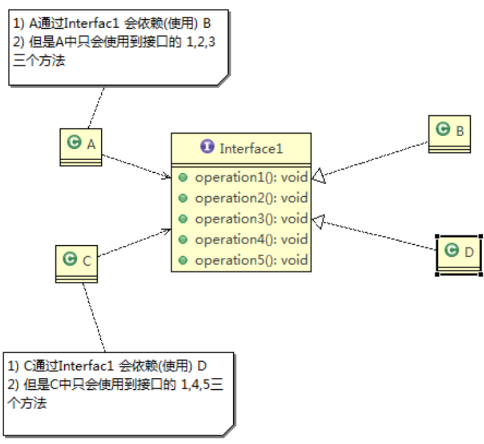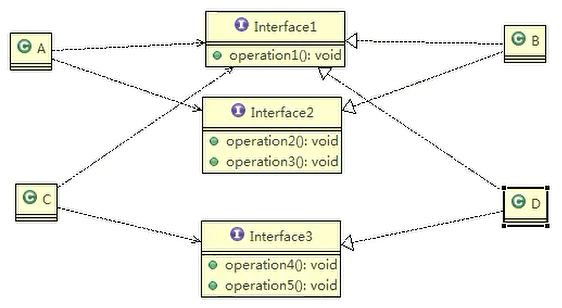0x02、设计模式原则 —— 接口隔离原则
概念
客户端不应该依赖它不需要的接口,即:一个类对另一个类的依赖应该建立在最小的接口上;(比较难理解这句话,但不要紧,请继续看下面)
演示
看下图,Inerface1接口中有5个抽象方法,其中,B和D为 抽象接口Interface1 的 实现类,A和C依赖于抽象接口 Interface1:

上图中,假设:类A 只用抽象类中的1、2、3三个方法,而4、5这两个方法类A是不需要的,而B类只用抽象接口中的1、4、5三个方法,同样2、3这两个方法类B是不需要的,我们就说,客户端A和C都有依赖了它们不需要的接口;违反了 接口隔离原则!
上图中的代码的实现:
interface Interface1 { void operation1(); void operation2(); void operation3(); void operation4(); void operation5(); } public class B : Interface1 { public void operation1() { Console.WriteLine("实现类B中的func1方法"); } public void operation2() { Console.WriteLine("实现类B中的func2方法"); } public void operation3() { Console.WriteLine("实现类B中的func3方法"); } public void operation4() { Console.WriteLine("实现类B中的func4方法"); } public void operation5() { Console.WriteLine("实现类B中的func5方法"); } } public class D : Interface1 { public void operation1() { Console.WriteLine("实现类D中的func1方法"); } public void operation2() { Console.WriteLine("实现类D中的func2方法"); } public void operation3() { Console.WriteLine("实现类D中的func3方法"); } public void operation4() { Console.WriteLine("实现类D中的func4方法"); } public void operation5() { Console.WriteLine("实现类D中的func5方法"); } } class A { // 类 A 中,通过接口 Interface1 依赖(使用)类B,但是只会用到 1、2、3 这两个方法 public void depend1(Interface1 interf) { interf.operation1(); } public void depend2(Interface1 interf) { interf.operation2(); } public void depend3(Interface1 interf) { interf.operation3(); } } class C { // 类 C 中,通过接口 Interface1 依赖(使用)类D,但是只会用到 1、4、5 这三个方法 public void depend1(Interface1 interf) { interf.operation1(); } public void depend4(Interface1 interf) { interf.operation4(); } public void depend5(Interface1 interf) { interf.operation5(); } }
上面代码中,类B 实现了接口中5个方法,而 类D 也实现了接口中的5个方法,但是 类A 中,我们并没有用到 operation4 和 operation5 这两个方法,同样的,类C 中页没有用到 operation2 和 operation3 这两个方法,既然没用到,那实现类不是白写了?
总结:上面代码中,类A通过接口Interface1依赖类B,类C通过接口Interface1依赖类D,如果接口Interface1对于类A和类C来说不是最小接口,那么类B和类D必须去实现他们不需要的方法
按隔离原则应当这样处理:将接口Interface1拆分为独立的几个接口,类A和类C分别与他们需要的接口建立依赖关系。也就是采用接口隔离原则!
改进:接口Interface1中出现的方法,根据实际情况拆分为三个接口:

public static void Main(string[] args) { A a = new A(); a.depend1(new B()); // 类A 通过接口依赖 类B a.depend2(new B()); a.depend3(new B()); C c = new C(); c.depend1(new D()); // 类C 通过接口依赖(使用) 类D c.depend4(new D()); c.depend5(new D()); } interface Interface1 { void operation1(); } interface Interface2 { void operation2(); void operation3(); } interface Interface3 { void operation4(); void operation5(); } public class B : Interface1,Interface2 { public void operation1() { Console.WriteLine("实现类B中的 operation1 方法"); } public void operation2() { Console.WriteLine("实现类B中的 operation2 方法"); } public void operation3() { Console.WriteLine("实现类B中的 operation3 方法"); } } public class D : Interface1, Interface3 { public void operation1() { Console.WriteLine("实现类D中的 operation1 方法"); } public void operation4() { Console.WriteLine("实现类D中的 operation4 方法"); } public void operation5() { Console.WriteLine("实现类D中的 operation5 方法"); } } class A { // 类A 通过接口 Interfacel,Interface2 依赖(使用)类B,但是只会用到1,2,3方法 public void depend1(Interface1 interf) { interf.operation1(); } public void depend2(Interface2 interf) { interf.operation2(); } public void depend3(Interface2 interf) { interf.operation3(); } } class C { // 类C 通过接口 Interfacel,Interface3 依赖(使用)类B,但是只会用到1、4、5方法 public void depend1(Interface1 interf) { interf.operation1(); } public void depend4(Interface3 interf) { interf.operation4(); } public void depend5(Interface3 interf) { interf.operation5(); } }
说白了就是:一个类依赖的接口中有我不需要的方法,那么我们需要将这个接口拆分成两个或多个接口,这样,拆分成多个接口之间就相当于隔离了,这就叫 接口隔离 ,我们依赖的才分后的接口就是最小了,这就叫:一个类对另一个类的依赖应该建立在最小的接口上;
即:我们依赖的接口中如果有用不到的成员,我们就将这个接口隔离,方式就是:拆,拆成我需要的接口,这种接口就是最小的;
这章其实不算难,如果有不懂的,欢迎评论区评论,我将会适度修改上面文章让大家都能大白话的理解它;
下一章,我们将继续深入:依赖倒置(倒转)原则

 浙公网安备 33010602011771号
浙公网安备 33010602011771号